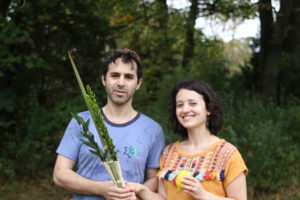
In our modern capitalist society, Jewish farmers can’t really observe the shmita year — the once every seven years tradition of letting the land lie fallow so farmers can rest and refresh themselves. There are too many economic forces at play.
But Jewish farmers can at least follow the spirit of the tradition, they say.
They can let pieces of the land lie fallow for the year, or they can use parts of it for more communal purposes like education. Following the spirit of the tradition still allows farmers, both locally and outside the Philadelphia area, to get some of the benefits of a traditional shmita year, like time for reflection and then a gradual re-centering and reorientation to the grind of cultivating the land.
As rabbinic authorities explained, shmita is like an extended Shabbat and, in a modern context, it can be like the current-day observation of the Sabbath: Jews finding a way to recharge, even if they’re not strictly following the letter of the Jewish law.
“How can you have more practices that nourish you?” said Rabbi Lauren Grabelle Herrmann, the founder of Kol Tzedek in Philadelphia and a spiritual leader at SAJ in New York City.
“A wide view of what it can mean to your life,” she added.
It’s also perfectly OK for farmers to not take shmita literally, as they aren’t actually required to by law. Halachic custom states that shmita only applies to Jews in Israel.
“As Jewish farmers in North America, we have zero obligation,” said Shani Mink, the executive director of the Jewish Farmer Network, which helps Jewish farmers across the United States.
So then, according to Mink, the question becomes, what can we learn from shmita by observing it in spirit?
William and Malya Levin, who run the Alliance Community Reboot, a nonprofit farming community in Salem County, New Jersey, took over their land after years of conventional farmers using pesticides and herbicides on it. But the Levins wanted to go organic, so they needed to detoxify the fields.
To get an organic certification from the United States Department of Agriculture, the husband-and-wife team had to uphold a requirement of abstinence from synthetic substances for 36 months. It was essentially three years of shmita, they said.
“It was recuperating,” Malya Levin added.

Three years into its organic farming life, the Alliance Community Reboot, or ACRe, is using the actual shmita year to cultivate another shmita-inspired effort. The Levins are turning a grant from Salem County into a model farm on a portion of their South Jersey property.
They plan to use the model farm for educational tours.
“Launching during the shmita year is appropriate,” Malya Levin said. “Taking a breath from commercial enterprise, showing why we do what we do.”
Yitzhak Glasman, who operates the Shalem Farm in Doylestown, is taking on a similar effort.
Glasman described his Bucks County land as “destroyed” when he took it over a year ago. So now, he’s in the process of “regenerating” it for farming use.
The farmer explained that shmita doesn’t apply to him because he doesn’t live in Israel. But he still believes in using its concepts to “manage and heal the land.”
Glasman also said that, “If I can experience the Shabbos, I can understand what the earth is experiencing.”
“Why it needs to rest and heal and regenerate,” he added.
Plus, even if organic farms like ACRe and Shalem aren’t literally observing shmita, they are pursuing the same goal that the Jewish tradition implies: sustainability.
The purpose of resting and recharging is to ultimately return and last longer, according to Glasman.
“Durable, long-term, long vision,” he said. “It’s a simple concept but it’s so useful in this capitalist society where everyone wants to produce, produce, produce.”
Useful, but still for the most part impractical, according to Perri Dejarnette, the assistant director of stewardship at the Pearlstone Center, a Maryland retreat center with an eight-acre organic farm. Dejarnette does not think of herself as a capitalist; yet she can’t escape its all-encompassing nature, she said.
At the same time, she agrees with Glasman: It’s valuable, both inherently and communally, to try and carve out spaces where you can.

Maybe you make like the Levins and Glasman and detox the land to purify it; or perhaps you follow the Levins’ lead in using land to build a more community-minded education space; or maybe you do what Pearlstone does and donate more produce to emergency recovery efforts and offer employees extra days off.
“It’s just another time for us to really go ahead and donate more produce, and also just being more open to the idea of radical rest,” Dejarnette said.
But even while Pearlstone does these things, they feel a little hollow, according to the assistant director. She said there’s a disconnection between following the spirit of shmita and observing shmita itself.
Shmita is community-oriented, according to Dejarnette. If you want to live like that, you need the people around you to do it, too. Communities have to plan in seven-year cycles to make sure they have enough food for the year of rest. Community members also must uphold the standard of letting the commons lie fallow.
Capitalism is at odds with those goals.
“We can only work within our current economic system,” Dejarnette said. “I’m stuck in this world, so I have to play the game.”
Jews outside Israel may not have to practice shmita, but Dejarnette believes it might benefit American Jews to live according to it anyway.
“If we thought of everything as commons, maybe we’d take better care of it,” she concluded. “Maybe we’d have more empathy.” JE




